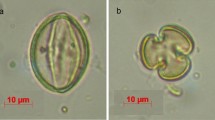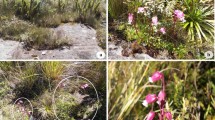Abstract
Minthostachys (Benth.) Spach (Lamiaceae) is one of the most important genus in Andean folk medicine. Minthostachys species are harvested in the wild rather than cultivated. Beyond the key socio-cultural role of these species, there have been no studies to evaluate their reproductive requirements as part of their conservation. M. verticillata is a gynodioecious species endemic from Argentina, whose populations are threatened because of overexploitation and habitat loss. The level of reproductive dependence on animal pollination, the diversity and composition of floral visitors’ assemblages, flower morphology, fruit and seed set and the progeny vigour of female and hermaphrodite plants were evaluated. Both sex morphs rely absolutely on animal pollination for seed production and were visited by a similar and diverse assemblage of insects (Diptera, Lepidoptera and Hymenoptera); however, the tachinind fly Ptilodexia cf. cingulipes was the main pollinator. Female plants have smaller flowers, higher fruit set, fruits with more seeds, and a higher percentage of seed germination than hermaphrodites. There were no differences in growth rate and biomass of seedlings produced by female and hermaphrodite plants. Lower reproductive success of hermaphrodites could be due to self-incompatibility or inbreeding depression. These results suggest that it is a fragile system where hermaphrodite plants perform mainly as pollen donors, females as seed producers, and seed production relies almost exclusively on a native tachinid species, which is furthermore parasitoid. This knowledge can be applied in conservation programs in order to promote the sexual reproduction and so the conservation in situ of this key medicinal resource.







Similar content being viewed by others
References
Ashman TL (1994) Reproductive allocation in hermaphrodite and female plants of Sidalcea oregana ssp. spicata (Malvaceae) using four currencies. Am J Bot 81(4):433–438
Ashman TL (2000) Pollinator selectivity and its implications for the evolution of dioecy and sexual dimorphism. Ecology 81(9):2577–2591
Ashman TL, Stanton M (1991) Seasonal variation in pollination dynamics of sexually dimorphic Sidalcea oregano ssp. Spicata (Malvaceae). Ecology 72(3):993–1003
Ashworth L, Quesada M, Casas A, Aguilar R, Oyama K (2009) Pollinator-dependent food production in Mexico. Biol Conserv 142:1050–1057
Asikainen E, Mutikainen P (2005) Preferences of pollinators and herbivores in gynodioecious Geranium sylvaticum. Ann Bot 95:879–886
Banchio E, Zygadlo J, Valladares GR (2005) Quantitative variations in the essential oil of Minthostachys mollis (Kunth.) Griseb. in response to insects with different feeding habits. J Agric Food Chem 53(17):6903–6906
Barboza GE, Cantero JJ, Núñez C, Pacciaroni A, Ariza-Espinar L (2009) Medicinal plants: a general review and a phytochemical and ethnopharmacological screening of the native Argentine Flora. Kurtziana 34:7–365
Barrett SCH (2002) Sexual interference of the floral kind. Heredity 88:154–159
Bates D, Maechler M, Bolker B, Walker S (2015) Fitting linear mixed-effects models using lme4. J Stat Softw 67(1):1–48
Bertin RI, Newman CM (1993) Dichogamy in angiosperms. Bot Rev 59:112–152
Blanchard EE (1966) Dípteros parásitos de scarabaeoideos argentinos. Rev Inves Agrop, Serie 5. Patol Veget 3:175–229
Cariddi L, Moser M, Andrada M, Demo M, Zygadlo J, Sabini L, Maldonado A (2009) The effect of Minthostachys verticillata essential oil on the immune response of patients allergic to dust mites. Bol Latinoam Caribe Plant Med y Aromat 8(3):224–233
Chacoff NP, Morales C, Garibaldi LA, Ashworth L, Aizen MA (2010) Pollinator dependence of Argentinian agriculture: current status and temporal analysis. Am J Plant Sci Biotechnol 3:106–116
Charlesworth D, Charlesworth A (1978) A model for the evolution of dioecy and gynodioecy. Am Nat 112:975–997
Charlesworth D, Charlesworth B (1987) Inbreeding depression and its evolutionary significance. Annu Rev Ecol Syst 18:237–268
Delph LF, Lively CM (1992) Pollinator visitation, floral display and nectar of the sexual morphs of a gynodioecius shrub. Oikos 63:161–170
Development Core Team R (2016) R: a language and environment for statistical computing. R foundation for statistical computing, Vienna
Fontaine C, Dajoz I, Meriguet J, Loreau M (2006) Functional diversity of plant-pollinator interaction webs enhances the persistence of plant communities. PLoS Biol 4:129–135
Garibaldi LA et al (2013) Wild pollinators enhance fruit set of crops regardless of honeybee abundance. Science 339:1608–1611
Gilbert F, Jervis M (1998) Functional, evolutionary and ecological aspects of feeding-related mouthpart specializations in parasitoid flies. Biol J Linn Soc 63(4):495–535
Giorgis MA, Cingolani AM, Chiarini F (2011) Composición florística del Bosque Chaqueño Serrano de la provincia de Córdoba, Argentina. Kurtziana 36:9–43
Guimarães JH (1977) Host-parasite and parasite-host catalogue of South American Tachinidae (Diptera). Arq Zool 28(3):1–131
Harder LD, Wilson WG (1998) A clarification of pollen discounting and its joint effect with inbreeding depression on mating-system evolution. Am Nat 152:684–695
Hong SP, Moon HK (2003) Gynodioecy in Lycopus maackianus Makino (Lamiaceae) in Korea: floral dimorphism and nutlet production. Flora 198:461–467
Husband B, Schemske DW (1996) Evolution of the magnitude and timing of inbreeding depression in plants. Evolution 50:54–70
Klatt BK, Holzschuh A, Westphal C, Clough Y, Smit I, Pawelzik E, Tscharntke T (2014) Bee pollination improves crop quality, shelf life and commercial value. Proc R Soc B 281:2013–2440
Klein AM, Vaissiere BE, Cane JH, Steffan-Dewenter I, Cunningham SA, Kremen C, Tscharntke T (2007) Importance of pollinators in changing landscapes for world crops. Proc R Soc B 274:303–313
Lewis D (1941) Male sterility in natural populations of hermaphrodite plants. New Phytol 50:56–63
Lewis D (1942) The evolution of sex in flowering plants. Biol Rev 17:46–67
Lloyd DG (1975) The maintenance of gynodioecy and androdioecy in angiosperms. Genetica 45:325–339
Lloyd DG, Webb CJ (1986) The avoidance of interference between the presentation of pollen and stigmas in angiosperms. I. Dichogamy. N Z J Bot 24:135–162
Mader E, Spivak M, Evans E (2010) Managing alternative pollinators: a handbook for beekeepers, growers, and conservationists. Natural Resource, Agriculture, and Engineering Service Cooperative Extension, Ithaca
Martínez GJ (2005) Recolección y Comercialización de Plantas Medicinales en el Departamento Santa María, Provincia de Córdoba, Argentina. Acta Farm Bonaer 24(4):575–584
Martínez GJ, Planchuelo AM, Fuentes E, Ojeda M (2006) A numeric index to establish conservation priorities for medicinal plants in the Paravachasca valley, Córdoba, Argentina. Biodivers Conserv 15:2457–2475
Morales CL (2009) Pollination requirement of raspberry in SW Argentina. Preliminary results. Int J Plant Reprod Biol 1:195–198
Ojeda M, Arroyo A, Borgogno P, Biderbost E, Balzarini M (2004) Yield of peperina (Minthostachys mollis (Kunth.) Griseb.) populations in the year following planting: response to cropping regimen. Span J Agric Res 2:393–399
Ollerton J, Winfree R, Tarrant S (2011) How many flowering plants are pollinated by animals? Oikos 120:321–326
Orford CA, Vaughan IP, Memmott J (2015) The forgotten flies: the importance of non-syrphid Diptera as pollinators. Proc R Soc B 282(1805):20142934
Pinheiro J, Bates D, Debroy S, Sarkar D, Core R, R Core team (2017) nlme: linear and nonlinear mixed effects models. R Package Vers 3:1–131
Rivkin LR, Case AL, Caruso CM (2016) Why is gynodioecy a rare but widely distributed sexual system? Lessons from the Lamiaceae. New Phytol. https://doi.org/10.1111/nph.13926
Rodriguez-Riaño T, Dafni A (2007) Pollen–stigma interference in two gynodioecious species of Lamiaceae with intermediate individuals. Ann Bot 100:423–431
Santos V, Ávila CJ (2009) Ocorrência de parasitismo em larvas de Liogenys Suturalis Blanchard, 1851 (Coleoptera: Melolonthidae) por Ptilodexia Brauer & Bergenstamm, 1889 (Diptera: Tachinidae). Arq Inst Biol 76(4):745–748
Schippmann U, Leaman DJ, Cunningham AB (2002) Impact of cultivation and gathering of medicinal plants on biodiversity: global trends and issues. Inter-Department Working Group on Biology Diversity for Food and Agriculture, FAO, Rome
Schippmann U, Leaman D, Cunningham AB (2006) A comparison of cultivation and wild collection of medicinal and aromatic plants under sustainability aspects. In: Bogers RJ, Craker LE, Lange D (eds) Medicinal and aromatic plants. Springer, Dordrecht, pp 75–95
Schmidt-Lebuhn AN (2008a) Revision of the genus Minthostachys (Labiatae). Mem N Y Bot Gard 98:1–74
Schmidt-Lebuhn AN (2008b) Ethnobotany, biochemistry and pharmacology of Minthostachys (Lamiaceae). J Enthnomaracol 118:343–353
Shykoff JA, Kolokotronis SO, Collin CL, López-Villavicencio M (2003) Effects of male sterility on reproductive traits in gynodioecious plants: a meta-analysis. Oecologia 135:1–9
Stireman JO, O’Hara JE, Wood DM (2006) Tachinidae, evolution, behaviour, and ecology. Ann Rev Entomol 51:525–555
Thompson JD, Taraire M (2000) Exploring the genetic basis and proximate causes of female fertility advantage in gynodioecious Thymus vulgaris. Evolution 54(5):1510–1520
Thompson JD, Rolland AG, Prugnolle F (2002) Genetic variation for sexual dimorphism in flower size within and between populations of gynodioecious Thymus vulgaris. J Evol Biol 15:362–372
Vasisht K, Sharma N, Karan M (2016) Current perspective in the international trade of medicinal plants material: an update. Curr Pharm Des 22(27):4288–4336
Wilcock C, Neiland MRM (2002) Pollination failure in plants: why it happens and when it matters. Trends Plant Sci 7:270–277
Woodcock TS, Larson BMH, Kevan PG, Inouye DW, Lunau K (2014) Flies and flowers II: floral attractants and rewards. J Pollinat Ecol 12(8):63–94
Acknowledgements
We are very grateful to Delia Susana Avalos and Moira Battan for identifying some Diptera specimens and to the authorities of La Quebrada and Los Manantiales nature reserves for allowing us to work there. We thank Ruben La Rossa and Marcela Gonzalez (INTA) for permitting the examination of Ptilodexia cf cingulipes type, and Marcelo Gritti for his technical assistance in editing the photographs. We would also like to thank María Pastor for her help with field work, Gabrielle McLellan for reviewing the English, and two anonymous reviewers and the Editor Dr. Heikki M. Hokkanen who improved the reading of the manuscript. E. Glinos holds a fellowship from the Consejo Nacional de Investigaciones Científicas y Técnicas (CONICET, Argentina) and L. Ashworth and P. Mulieri are researchers from the same institution. This study was supported by a Grant from CONICET [PIP 00371] and Programa Iberoamericano de Ciencia y Tecnología para el Desarrollo RED CYTED-SEPODI (417RT0527).
Author information
Authors and Affiliations
Corresponding author
Additional information
Handling editor: Kristine Nemec.
Publisher's Note
Springer Nature remains neutral with regard to jurisdictional claims in published maps and institutional affiliations.
Rights and permissions
About this article
Cite this article
Glinos, E., Condat, E., Mulieri, P. et al. Essential dependence on wild pollination service: a medicinal plant under threat Minthostachys verticillata (Lamiaceae). Arthropod-Plant Interactions 13, 865–874 (2019). https://doi.org/10.1007/s11829-019-09705-z
Received:
Accepted:
Published:
Issue Date:
DOI: https://doi.org/10.1007/s11829-019-09705-z




